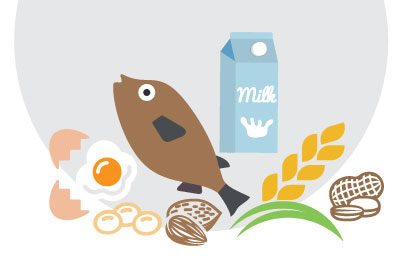If your child has food allergies, his paediatrician may recommend that he be placed on a food elimination diet. What it means is that you will need to temporarily eliminate specific foods from his diet, and possibly your diet as well if you are still breastfeeding him. The elimination diet should last around 2-4 weeks.
This method is normally combined with skin or blood tests, and its purpose is to help identify specific foods which are triggering his food allergies. By avoiding the suspected food trigger, both you and his paediatrician can monitor his symptoms, e.g. his symptoms should disappear if the foods that trigger his allergy are not on the elimination diet. As an additional step to help determine the exact offending food, his paediatrician may ask for it to be reintroduced to his diet gradually. Any return of his symptoms would signify that he is likely allergic to the food that was reintroduced.
Allergy vs intolerance
Food allergies are caused by the immune system mistakenly identifying specific foods to be harmful, thus reacting by creating immunoglobulin E (IgE) antibodies to combat the perceived threat. This often results in fairly immediate symptoms (within minutes) which could present as gut-related (abdominal pain, vomiting or diarrhoea), skin reactions (rashes, itching or swelling), respiratory (runny nose, sneezing or difficulty breathing), or even headaches in older children.
Food intolerance on the other hand, is a purely gut-related problem that is caused by difficulty in digesting certain foods – the immune system is not reacting in any way. Symptoms such as bloating, tummy aches, or diarrhoea, do not normally appear immediately and can take a while before presenting.
Getting started
The eight most common allergenic foods listed by the US Food & Drug Administration are milk, eggs, fish (bass, flounder, cod), crustacean shellfish (crab, lobster, shrimp), tree nuts (almonds, walnuts, pecans), peanuts, wheat, and soybeans.
While preparing fresh foods using raw ingredients may be the best solution, this may not always be possible. Do exercise extra care whenever you buy processed foods. It is imperative that you read the product labels carefully before buying and serving them to your child. This will help ensure that the processed foods you buy do not contain any of the foods that are in his food elimination diet.
As an example, if soy is part of the foods to be eliminated, buying processed foods that contain soy (commonly labelled as lecithin) would most likely skew the results, particularly if your child is allergic to soy. Other common ingredients to be aware of include flour, which is often listed as wheat, and whey, which is often listed as milk. If you are unsure about the processed food, it would be better to err on the side of caution and avoid it.
Keeping track
Keeping a food diary in conjunction with the food elimination diet is a good habit, as it could potentially be useful to help in identifying problem foods. Make it a point to accurately record all symptoms (including number of times and duration) and everything that your child ate or drank. In addition to food and drinks taken during main meals, this should also include prescribed medicines, supplements, and any sweets or snacks he takes. Yes, even taking a taste from someone else’s plate or cup counts!
Start with a fresh page every day. Remember to bring it along with any food packaging or labels during consultation sessions with your child’s allergist, in order to give him a complete picture to help him in his analysis.
Tips for success
By this point, it should be apparent that going on a food elimination diet can be quite complex. It is important to plan it and ensure that you take careful note throughout the course of the elimination diet. Here are things you can do to help yourself:
- Preparation is key – spend a little time doing some research prior to starting the elimination diet. Do search for eliminationdiet-friendly recipes beforehand. You may also want to search for suitable processed foods ahead of time.
- Stock up before starting – in addition to getting recipes, you should also ensure that you have all the necessary ingredients ahead of time. Be sure to also stock up on snacks or light foods that are elimination-dietfriendly. This will help increase your chances of following the elimination diet, especially on days when your child is hungry or just wants something to nibble on.
- Clean out the clutter – take some time to go through your kitchen and other parts of your house to look for foods that are not elimination-diet-friendly. Make sure that you either hide them well, discard them (if they are almost expired) or give them away. By removing non-elimination-diet-friendly foods, you also remove any temptation to your child. This will pre-empt situations where your child may see his favourite snack (that is part of the eliminated food) in plain sight and demands to have some.
- Keep all caregivers in the loop – be sure to involve all caregivers in this exercise as they will help ensure that your child adheres to his elimination diet. This includes the people who will care for him in daycare, kindergarten or school. For school-going children, it is important that you discuss this in detail with him in order to ensure his cooperation as well. You may need to prepare meals for him, unless you are 100% sure that the foods prepared by the canteen can comply with his elimination diet. It may also be necessary to inform family members and parents of friends in order to avoid accidentally sharing/giving food.
Lastly, do note that the elimination diet may not yield conclusive results, in which case your child’s allergist may recommend an oral food challenge in order to check any inconclusive results. However, it is very important that any elimination diets be taken ONLY under the supervision of an experienced medical professional, in order to avoid possible problems such as malnutrition.









Comments